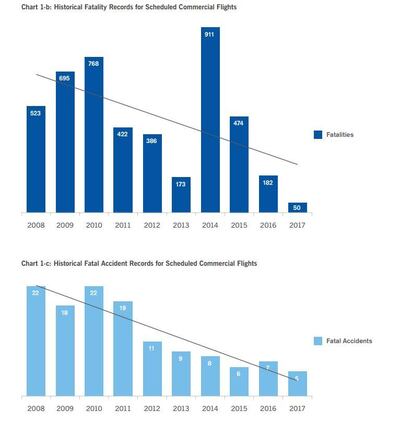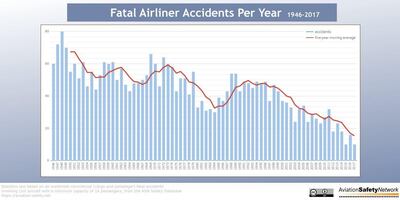Some 500 passengers have died in commercial aircraft accidents around the world so far in 2018, a sad total which includes the 189 presumed dead from today's Lion Air crash in Indonesia - the Asian airline's first fatal crash after a series of incidents.
The numbers suggest a slight increase in the average annual number of airline fatalities over the past 10 years. According to data from the Montreal-based International Civil Aviation Organisation, the leading safety authority and regulator of the global airline industry, there have been 4,584 deaths from accidents involving scheduled commercial flights in the decade to date - an average of 459 per year.
Yet these tallies and our own flawed risk perceptions mask the fact that flying remains the safest form of transport there is. Life itself is not without risk, and yet statistically, air travel is almost as close to risk-free as it gets, even as the number of those travelling continues to rise. Globally in 2017, 4.1 billion passengers travelled by air, with a total of just 50 fatalities from accidents involving scheduled commercial flights. This equates to a fatality rate of 12.2 deaths per billion passengers, representing the safest year ever on record for aviation. This means your chance of being involved in a catastrophic air crash last year were about one in 83 million.
The total number of air accidents, both fatal and non-fatal, has stayed low at between 2.1 and 3 accidents per million departures between 2013 and last year. Even discounting the somewhat anomalous air accident fatalities of last year, 2016 saw a total of 182 deaths, 2015 saw 474 deaths and 2014 saw 911 deaths, according to the ICAO's latest safety report.
2014 saw three horrific accidents including AirAsia flight 8501, which crashed into the Java Sea en-route from Surabaya to Singapore, killing 162 people and the double whammy of Malaysia Airlines Flight 17 (MH17) from Amsterdam to Kuala Lumpur, which was shot down over Ukraine, killing all 283 passengers and 15 crew, and the disappearance of MH370, which disappeared while flying from Kuala Lumpur to Beijing, with 227 passengers on board.
What seems clear is that many of the accidents are taking place in Asia, where the biggest growth in air travel is taking place. Yet passengers can take heart from the fact that with scheduled commercial international and domestic flights accounting for over 100,000 scheduled flights a day - 35 million departures a year -even 2014's high figure meant that in that year there were just three accidents (fatal or non-fatal) per million departures.
This compares with 1.25 million who are now killed annually in road accidents worldwide. Car travel is approximately 100 times more dangerous than flying, and travelling on a motorbike is a staggering 3,000 times more deadly. Even train travel is, kilometre-for-kilometre, twice as dangerous as going by air.
Yes, air crashes are catastrophic, but they grab the attention only because other forms of transport such as driving offer a greater sense of control and kill fewer people each time. But road accidents go on every second of every day, all over the world - so often that keeping an individual tally as the world's aviation safety experts do with air travel would be impossible.
__________
Read more:
Air safety: the challenges ahead
On the move: modern air safety is a wonder in our fractured world
Air safety in 2018: should we be concerned about flying?
__________


